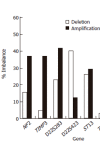Amplification of D22S283 as a favorable prognostic indicator in liver fluke related cholangiocarcinoma
- PMID: 16865775
- PMCID: PMC4087744
- DOI: 10.3748/wjg.v12.i27.4338
Amplification of D22S283 as a favorable prognostic indicator in liver fluke related cholangiocarcinoma
Abstract
Aim: To analyze the DNA copy number of target genes NF2, TIMP3, ST13, TOB2, BIK, and TP and the reference microsatellite markers D22S283, D22S423, and D22S274 mapped on 22q12-qter in liver fluke related cholangiocarcinoma (CCA) and define its correlation with clinical parameters.
Methods: Quantitative real time PCR (qPCR) was used for determining allelic imbalances in 65 liver fluke related CCA tissues. Statistical correlations between allelic imbalances and clinicopathological parameters, i.e. age, sex, tumor stage, histological type, blood vessel invasion, nerve invasion and lymphatic invasion were evaluated by means of the chi2 test. Cox regression analysis was used for determining patient's survival.
Results: Amplifications of the TP (22q13.33), TOB2 (22q13.2-13.31), D22S283 (22q12.3), TIMP3 (22q12.3) and NF2 (22q12.2) were found in 35 (53.8%), 28 (43.1%), 27 (41.5%), 24 (36.9%), and 24 (36.9%), respectively. Losses at the D22S423 (22q13.1-13.2) and BIK (22q13.31) were detected in 26 (40%) and 23 (35.4%), respectively. Significant correlations were observed between lymphatic invasion and allelic losses of BIK (P = 0.025) and D22S283 (P = 0.041). Univariate and multivariate Cox regression analysis revealed D22S283 amplification as an independent predictor of good prognosis (P = 0.006, death hazard ratio = 0.411, 95% CI = 0.217-0.779) and blood vessel invasion as an independent poor prognostic factor (P = 0.042, death hazard ratio = 1.911, 95% CI = 1.022-3.571) in CCA patients.
Conclusion: This study provides evidence for the involvement of gene amplification and deletion on chromosome 22q in liver fluke related CCA. This is the first report of D22S283 amplification as an independent indicator of favorable prognosis in liver fluke related CCA.
Figures



Similar articles
-
Amplification of chromosome 21q22.3 harboring trefoil factor family genes in liver fluke related cholangiocarcinoma is associated with poor prognosis.World J Gastroenterol. 2006 Jul 14;12(26):4143-8. doi: 10.3748/wjg.v12.i26.4143. World J Gastroenterol. 2006. PMID: 16830362 Free PMC article.
-
Prognostic significance of microsatellite alterations at 1p36 in cholangiocarcinoma.World J Gastroenterol. 2006 Jul 21;12(27):4377-82. doi: 10.3748/wjg.v12.i27.4377. World J Gastroenterol. 2006. PMID: 16865781 Free PMC article.
-
Cyclophilin A enhances cell proliferation and tumor growth of liver fluke-associated cholangiocarcinoma.Mol Cancer. 2011 Aug 26;10:102. doi: 10.1186/1476-4598-10-102. Mol Cancer. 2011. PMID: 21871105 Free PMC article.
-
Potential targeted therapy for liver fluke associated cholangiocarcinoma.J Hepatobiliary Pancreat Sci. 2014 Jun;21(6):362-70. doi: 10.1002/jhbp.65. Epub 2014 Jan 10. J Hepatobiliary Pancreat Sci. 2014. PMID: 24408866 Review.
-
Liver fluke induces cholangiocarcinoma.PLoS Med. 2007 Jul;4(7):e201. doi: 10.1371/journal.pmed.0040201. PLoS Med. 2007. PMID: 17622191 Free PMC article. Review.
Cited by
-
Genetic and environmental determinants of risk for cholangiocarcinoma in Thailand.World J Gastrointest Pathophysiol. 2014 Nov 15;5(4):570-8. doi: 10.4291/wjgp.v5.i4.570. World J Gastrointest Pathophysiol. 2014. PMID: 25401000 Free PMC article. Review.
-
Array comparative genomic hybridization identifies novel potential therapeutic targets in cholangiocarcinoma.HPB (Oxford). 2011 May;13(5):309-19. doi: 10.1111/j.1477-2574.2010.00286.x. Epub 2011 Mar 10. HPB (Oxford). 2011. PMID: 21492330 Free PMC article.
-
Effects of thymidine phosphorylase on tumor aggressiveness and 5-fluorouracil sensitivity in cholangiocarcinoma.World J Gastroenterol. 2010 Apr 7;16(13):1631-8. doi: 10.3748/wjg.v16.i13.1631. World J Gastroenterol. 2010. PMID: 20355241 Free PMC article.
-
The Identification of the Metabolism Subtypes of Skin Cutaneous Melanoma Associated With the Tumor Microenvironment and the Immunotherapy.Front Cell Dev Biol. 2021 Aug 12;9:707677. doi: 10.3389/fcell.2021.707677. eCollection 2021. Front Cell Dev Biol. 2021. PMID: 34458265 Free PMC article.
References
-
- Haswell-Elkins MR, Satarug S, Tsuda M, Mairiang E, Esumi H, Sithithaworn P, Mairiang P, Saitoh M, Yongvanit P, Elkins DB. Liver fluke infection and cholangiocarcinoma: model of endogenous nitric oxide and extragastric nitrosation in human carcinogenesis. Mutat Res. 1994;305:241–252. - PubMed
-
- Ohshima H, Bandaletova TY, Brouet I, Bartsch H, Kirby G, Ogunbiyi F, Vatanasapt V, Pipitgool V. Increased nitrosamine and nitrate biosynthesis mediated by nitric oxide synthase induced in hamsters infected with liver fluke (Opisthorchis viverrini) Carcinogenesis. 1994;15:271–275. - PubMed
-
- Vatanasapt V, Sriamporn S, Vatanasapt P. Cancer control in Thailand. Jpn J Clin Oncol. 2002;32 Suppl:S82–S91. - PubMed
-
- Uttaravichien T, Bhudhisawasdi V, Pairojkul C, Pugkhem A. Intrahepatic cholangiocarcinoma in Thailand. J Hepatobiliary Pancreat Surg. 1999;6:128–135. - PubMed
-
- Horie S, Endo K, Kawasaki H, Terada T. Overexpression of MDM2 protein in intrahepatic cholangiocarcinoma: relationship with p53 overexpression, Ki-67 labeling, and clinicopathological features. Virchows Arch. 2000;437:25–30. - PubMed
Publication types
MeSH terms
Substances
LinkOut - more resources
Full Text Sources
Medical
Miscellaneous

